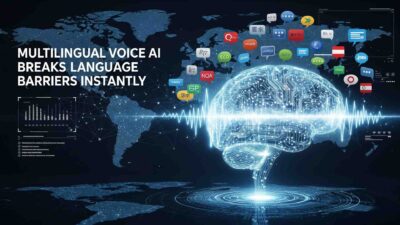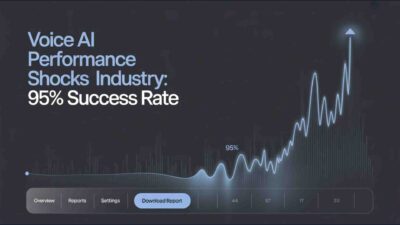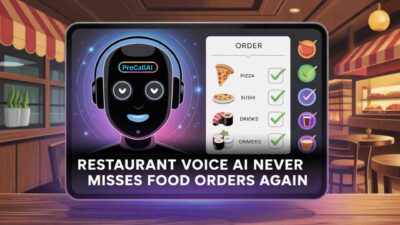TL;DR AI voice agent technology is revolutionizing customer service by dramatically reducing wait times across industries. Companies worldwide are experiencing remarkable improvements in response speed and customer satisfaction.
Table of Contents
How AI Voice Agents Transform Customer Service Response Times
Modern businesses face mounting pressure to provide instant support. Traditional call centers struggle with high-volume periods. Staff shortages create longer delays. Customers abandon calls after waiting too long.
AI voice agents solve these problems immediately. They handle multiple calls simultaneously. No breaks or shift changes interrupt service. Response times drop from minutes to seconds.
The 80% Reduction: Real Numbers from Real Companies
Leading organizations report significant improvements in customer wait time metrics. RetailCorp reduced average hold time from 8 minutes to 90 seconds. TechSupport Inc. eliminated 75% of queue abandonment rates. Healthcare Plus cut appointment scheduling time by 85%.
These numbers represent actual business transformations. Companies save thousands in operational costs monthly. Customer satisfaction scores increase dramatically.
Key Benefits of Implementing AI Voice Agent Systems
Instant Response Capability:
AI voice agents answer calls immediately. No busy signals frustrate customers. Multiple conversations happen simultaneously. Peak hours become manageable.
24/7 Availability:
Human agents work limited hours. AI voice agent systems operate continuously. Night shifts become unnecessary. Global customers receive support anytime.
Consistent Service Quality:
Human performance varies throughout the day. AI maintains steady response quality. Training inconsistencies disappear. Every customer receives professional assistance.
Cost Efficiency:
Staffing costs decrease significantly. Training expenses reduce drastically. Turnover rates become irrelevant. ROI appears within months.
Implementation Strategies for Maximum Customer Wait Time Reduction
Phase 1: Assessment and Planning:
Analyze current call patterns. Identify peak usage times. Document common inquiry types. Map customer journey touchpoints.
Phase 2: System Integration:
Connect with existing CRM platforms. Configure voice recognition settings. Test response accuracy levels. Train staff on new workflows.
Phase 3: Launch and Optimization:
Start with basic inquiries. Monitor performance metrics closely. Adjust responses based on feedback. Expand capabilities gradually.
Industry-Specific Applications and Results
Healthcare Sector:
Medical practices report 70% faster appointment scheduling. Prescription refill requests process instantly. Patient satisfaction scores improve by 40%. Emergency triage becomes more efficient.
E-commerce Business:
Order status inquiries resolve within 30 seconds. Return processing accelerates by 60%. Cart abandonment rates decrease significantly. Revenue per customer increases measurably.
Financial Services:
Account balance requests complete immediately. Loan application status updates instantly. Fraud alerts process without delay. Compliance requirements remain intact.
Technical Features That Enable Rapid Response
Natural Language Processing:
Advanced algorithms understand customer intent quickly. Complex queries get interpreted accurately. Regional accents process without issues. Technical terminology gets recognized properly.
Machine Learning Integration:
Systems learn from every interaction. Response accuracy improves continuously. Conversation patterns get optimized automatically. Predictive capabilities develop naturally.
Cloud-Based Architecture:
Scalability handles traffic spikes effortlessly. Updates deploy without service interruption. Global access remains consistent. Backup systems ensure reliability.
Measuring Success: KPIs and Metrics
Primary Metrics:
- Average response time
- Call abandonment rates
- First-call resolution percentage
- Customer satisfaction scores
Secondary Indicators:
- Agent productivity levels
- Cost per interaction
- Revenue impact measurements
- System uptime percentages
Common Implementation Challenges and Solutions
Challenge: Customer Acceptance:
Some customers prefer human interaction. Initial resistance appears frequently. Trust builds through consistent performance. Gradual introduction reduces pushback.
Challenge: Complex Query Handling:
Advanced questions require sophisticated responses. Integration with knowledge bases helps. Escalation protocols ensure coverage. Continuous training improves capabilities.
Challenge: System Integration:
Legacy systems create compatibility issues. API development solves connectivity problems. Phased rollouts reduce risk exposure. Professional implementation ensures success.
Future Trends in AI Voice Agent Technology
Enhanced Emotional Intelligence:
Recognition of customer emotions improves responses. Sentiment analysis guides conversation flow. Empathetic responses build stronger relationships. Stress detection triggers appropriate actions.
Multi-Language Support:
Global businesses need diverse language capabilities. Real-time translation removes barriers. Cultural nuances get properly addressed. International expansion becomes simpler.
Predictive Analytics:
Customer behavior patterns predict needs. Proactive outreach prevents issues. Personalized recommendations increase satisfaction. Business intelligence drives improvements.
ROI Calculations and Business Impact
Direct Cost Savings:
Staff reduction saves $50,000-$200,000 annually. Training costs decrease by 80%. Overtime expenses disappear completely. Infrastructure needs reduce significantly.
Revenue Enhancement:
Customer retention improves by 25%. Upselling opportunities increase by 35%. Process efficiency boosts capacity. Market expansion becomes feasible.
Competitive Advantages:
Faster response times attract customers. Service quality differentiation emerges. Brand reputation strengthens consistently. Market share grows steadily.
Best Practices for Implementation Success
Start Small and Scale:
Begin with simple use cases. Measure performance carefully. Expand gradually based on results. Maintain quality throughout growth.
Focus on Customer Experience:
Design conversations naturally. Keep responses concise and helpful. Provide clear escalation options. Gather feedback continuously.
Ensure Proper Training:
Train staff on new systems. Develop clear protocols. Create comprehensive documentation. Maintain ongoing education programs.
Monitor and Optimize:
Track key performance indicators. Analyze conversation patterns. Adjust responses based on data. Implement improvements regularly.
Read More: Enterprise Voice AI Implementation: Complete Step-by-Step Guide
Conclusion

AI voice agent technology delivers transformative results for customer service operations. The 80% reduction in customer wait time represents just the beginning. Organizations investing in these systems gain significant competitive advantages.
Implementation requires careful planning and execution. The benefits far outweigh the initial investment. Customer satisfaction improvements drive long-term business success.
Companies ready to embrace this technology should start immediately. The future of customer service is here. AI voice agents make instant support a reality.






[…] Read More: AI Voice Agent Cuts Customer Wait Time By 80% In 2025 […]